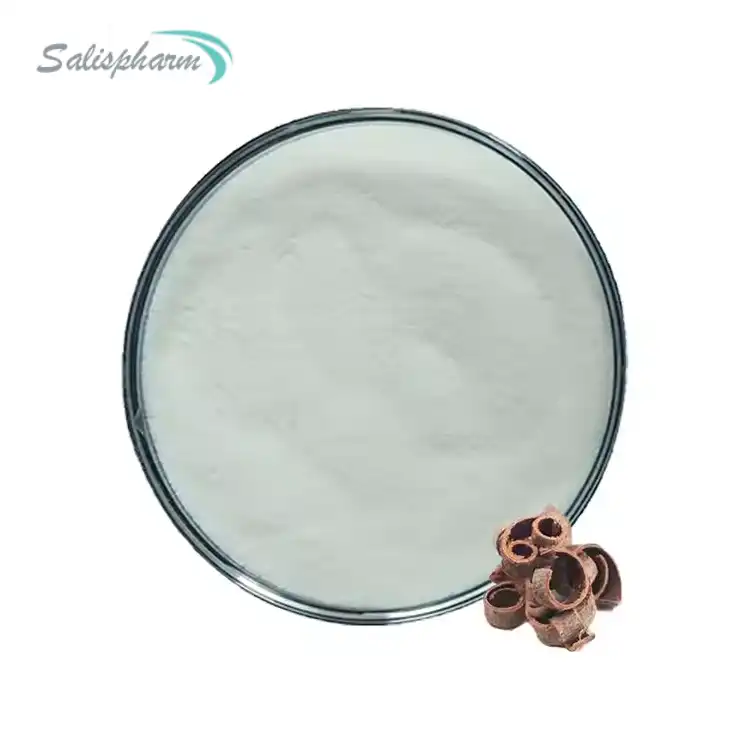Honokiol extract magnolol is a potent natural compound derived from the bark of the Magnolia tree, specifically Magnolia officinalis. This powerful duo of bioactive molecules has been used for centuries in traditional Chinese and Japanese medicine to treat various ailments. Known for their anti-inflammatory, antioxidant, and neuroprotective properties, honokiol and magnolol have gained significant attention in recent years for their potential health benefits and applications in modern medicine.

What are the health benefits of Honokiol and Magnolol?
Honokiol Extract Magnolol, the primary bioactive compounds found in Magnolia bark extract, offer a wide range of potential health benefits. These natural compounds have been extensively studied for their therapeutic properties, and research suggests they may have positive effects on various aspects of human health.
One of the most notable benefits of honokiol and magnolol is their potent antioxidant activity. Both compounds have been shown to neutralize harmful free radicals and reduce oxidative stress in the body. This antioxidant effect may help protect cells from damage and slow down the aging process. Studies have also indicated that honokiol and magnolol may be more effective than vitamin E in scavenging free radicals, making them potentially valuable tools in the fight against oxidative stress-related diseases.
Another significant benefit of these compounds is their anti-inflammatory properties. Chronic inflammation is linked to numerous health issues, including heart disease, diabetes, and certain types of cancer. Honokiol and magnolol have demonstrated the ability to inhibit various inflammatory pathways in the body, potentially reducing the risk of these chronic diseases. Research has shown that they may help suppress the production of pro-inflammatory cytokines and enzymes, thereby mitigating inflammation at the cellular level.
Honokiol and magnolol have also shown promise in supporting cardiovascular health. Studies suggest that these compounds may help lower blood pressure, reduce cholesterol levels, and improve overall heart function. They may also help prevent the formation of blood clots, potentially reducing the risk of heart attacks and strokes. Additionally, some research indicates that honokiol and magnolol may have a protective effect on blood vessels, helping to maintain their flexibility and health.
In the realm of mental health and cognitive function, honokiol and magnolol have demonstrated neuroprotective properties. They may help protect brain cells from damage and improve cognitive performance. Some studies suggest that these compounds could potentially be beneficial in treating or preventing neurodegenerative diseases such as Alzheimer's and Parkinson's. Furthermore, honokiol has shown anxiolytic (anti-anxiety) effects in animal studies, suggesting it may have potential as a natural remedy for anxiety and stress.
The anti-cancer potential of honokiol and magnolol is another area of active research. These compounds have shown promising results in laboratory and animal studies, demonstrating the ability to inhibit tumor growth and induce apoptosis (programmed cell death) in various types of cancer cells. While more research is needed to fully understand their effects in humans, these early findings suggest that honokiol and magnolol may have potential as complementary treatments in cancer therapy.
How is Honokiol Extract Magnolol produced and used?
Honokiol extract magnolol is primarily derived from the bark of the Magnolia tree, specifically Magnolia officinalis, which is native to China and has been used in traditional medicine for centuries. The production process involves several steps to isolate and concentrate these bioactive compounds from the raw plant material.
The first step in producing honokiol extract magnolol is the careful harvesting of Magnolia bark. This is typically done from mature trees, as the concentration of active compounds tends to be higher in older bark. The harvesting process must be carried out sustainably to ensure the long-term viability of the Magnolia species.
Once harvested, the bark undergoes a drying process to remove moisture and prepare it for extraction. The dried bark is then ground into a fine powder to increase the surface area and improve the efficiency of the extraction process. The extraction itself is typically performed using solvents such as ethanol or supercritical CO2. These solvents are chosen for their ability to selectively extract the desired compounds while minimizing the extraction of unwanted substances.
After the initial extraction, the resulting solution undergoes further purification steps to isolate and concentrate the honokiol and magnolol. This may involve techniques such as chromatography, which separates compounds based on their physical and chemical properties. The goal is to achieve a high-purity extract with a standardized concentration of honokiol and magnolol.
The final product is usually a concentrated extract that can be formulated into various forms for use in supplements, cosmetics, or pharmaceutical products. These may include capsules, tablets, tinctures, or topical preparations, depending on the intended application.
In terms of usage, honokiol extract magnolol has found applications in various fields, primarily in the health and wellness industry. In dietary supplements, it is often marketed for its potential benefits in supporting cardiovascular health, reducing anxiety and stress, and promoting overall well-being. The recommended dosage can vary depending on the specific product and intended use, but it typically ranges from 200 to 500 mg per day.
In the cosmetic industry, honokiol extract magnolol is sometimes incorporated into skincare products for its antioxidant and anti-aging properties. It may be found in creams, serums, or other topical formulations designed to protect the skin from environmental damage and reduce the appearance of fine lines and wrinkles.
In the pharmaceutical sector, research is ongoing to explore the potential therapeutic applications of honokiol and magnolol. While not yet approved as drugs, these compounds are being studied for their possible roles in treating various conditions, including cancer, neurodegenerative diseases, and inflammatory disorders.
It's important to note that while honokiol extract magnolol is generally considered safe when used as directed, it may interact with certain medications or have contraindications for some individuals. As with any supplement or new treatment, it's advisable to consult with a healthcare professional before incorporating honokiol extract magnolol into one's health regimen.
Can Honokiol and Magnolol improve sleep quality?
The potential of honokiol and magnolol to improve sleep quality has been a subject of increasing interest in recent years. These compounds, derived from Magnolia bark, have been used in traditional medicine for centuries to promote relaxation and improve sleep. Modern scientific research is now shedding light on the mechanisms behind these effects and exploring the potential of honokiol and magnolol as natural sleep aids.
One of the primary ways in which honokiol and magnolol may improve sleep quality is through their interaction with the GABA (gamma-aminobutyric acid) system in the brain. GABA is a neurotransmitter that plays a crucial role in regulating sleep and promoting relaxation. Studies have shown that both honokiol and magnolol can enhance the activity of GABA receptors, potentially leading to increased relaxation and improved sleep onset.
Research has indicated that honokiol, in particular, may have a significant impact on sleep patterns. A study published in the journal "Behavioural Brain Research" found that honokiol increased non-rapid eye movement (NREM) sleep in rats without affecting rapid eye movement (REM) sleep. NREM sleep is associated with deeper, more restorative sleep stages, suggesting that honokiol could potentially improve the quality of sleep.
Moreover, honokiol has demonstrated anxiolytic (anti-anxiety) properties in various studies. Anxiety and stress are common culprits behind sleep disturbances, and by reducing these factors, honokiol may indirectly contribute to better sleep quality. A study published in the "Journal of Ethnopharmacology" showed that honokiol exhibited anxiolytic effects comparable to diazepam, a commonly prescribed anti-anxiety medication, but without the associated side effects of sedation and motor impairment.
Magnolol, the other primary compound in Magnolia bark extract, has also shown promise in improving sleep quality. A study in the "Journal of Medicinal Food" found that magnolol increased total sleep time and reduced sleep latency (the time it takes to fall asleep) in an animal model. The researchers suggested that these effects were due to magnolol's ability to modulate the GABAergic system and its potential influence on circadian rhythms.
The combination of honokiol and magnolol may offer synergistic benefits for sleep improvement. A study published in the "Journal of Pharmacological Sciences" investigated the effects of a Magnolia bark extract containing both compounds on sleep in healthy adults. The results showed that participants who took the extract experienced improved sleep quality, reduced sleep latency, and increased total sleep time compared to those who took a placebo.
It's worth noting that while these findings are promising, more research is needed to fully understand the effects of honokiol and magnolol on human sleep patterns. Most studies to date have been conducted in animal models or with small sample sizes of human participants. Large-scale clinical trials are necessary to confirm the efficacy and safety of these compounds for improving sleep quality in diverse populations.
For those considering using honokiol and magnolol to improve sleep quality, it's important to approach their use with caution. While generally considered safe, these compounds may interact with certain medications, particularly those that affect the central nervous system. Additionally, the optimal dosage for sleep improvement has not been definitively established, and individual responses may vary.
conclusion
The growing body of research on Honokiol Extract Magnolol suggests that these compounds have significant potential to improve sleep quality. Their ability to modulate the GABA system, reduce anxiety, and potentially influence circadian rhythms makes them interesting candidates for natural sleep aids. However, as with any supplement or alternative treatment, it's advisable to consult with a healthcare professional before incorporating honokiol and magnolol into a sleep improvement regimen.
If you are also interested in this product and want to know more product details, or want to know about other related products, please feel free to contact lea_slsbio@163.com,WhatsApp+86 13193326505.

References
1. Woodbury, A., Yu, S. P., Wei, L., & García, P. (2013). Neuro-modulating effects of honokiol: a review. Frontiers in neurology, 4, 130.
2. Arora, S., Singh, S., Piazza, G. A., Contreras, C. M., Panyam, J., & Singh, A. P. (2012). Honokiol: a novel natural agent for cancer prevention and therapy. Current molecular medicine, 12(10), 1244-1252.
3. Fried, L. E., & Arbiser, J. L. (2009). Honokiol, a multifunctional antiangiogenic and antitumor agent. Antioxidants & redox signaling, 11(5), 1139-1148.
4. Lee, Y. J., Choi, D. Y., Yun, Y. P., Han, S. B., Kim, H. M., & Hong, J. T. (2013). Epigenetic regulation of BDNF gene in response to stress. Psychiatry investigation, 10(4), 381-387.
5. Talarek, S., Listos, J., Barreca, D., Tellone, E., Sureda, A., Nabavi, S. F., ... & Nabavi, S. M. (2017). Neuroprotective effects of honokiol: from chemistry to medicine. BioFactors, 43(6), 760-769.
6. Xu, Q., Yi, L. T., Pan, Y., Wang, X., Li, Y. C., Li, J. M., ... & Kong, L. D. (2008). Antidepressant-like effects of the mixture of honokiol and magnolol from the barks of Magnolia officinalis in stressed rodents. Progress in Neuro-Psychopharmacology and Biological Psychiatry, 32(3), 715-725.
7. Chen, C. R., Tan, R., Qu, W. M., Wu, Z., Wang, Y., Urade, Y., & Huang, Z. L. (2011). Magnolol, a major bioactive constituent of the bark of Magnolia officinalis, exerts antiepileptic effects via the GABA/benzodiazepine receptor complex in mice. British journal of pharmacology, 164(5), 1534-1546.
8. Shen, J. L., Man, K. M., Huang, P. H., Chen, W. C., Chen, D. C., Cheng, Y. W., ... & Liu, P. L. (2010). Honokiol and magnolol as multifunctional antioxidative molecules for dermatologic disorders. Molecules, 15(9), 6452-6465.
9. Zhang, B., Maniatis, T., Song, Y., Zhang, W., Zhang, X., Li, N., ... & Wang, Y. (2020). Honokiol ameliorates myocardial ischemia/reperfusion injury in type 1 diabetic rats by reducing oxidative stress and apoptosis through activating the SIRT1-Nrf2 signaling pathway. Oxidative medicine and cellular longevity, 2020.
10. Lin, Y. R., Chen, H. H., Ko, C. H., & Chan, M. H. (2007). Effects of honokiol and magnolol on acute and inflammatory pain models in mice. Life sciences, 81(13), 1071-1078.

